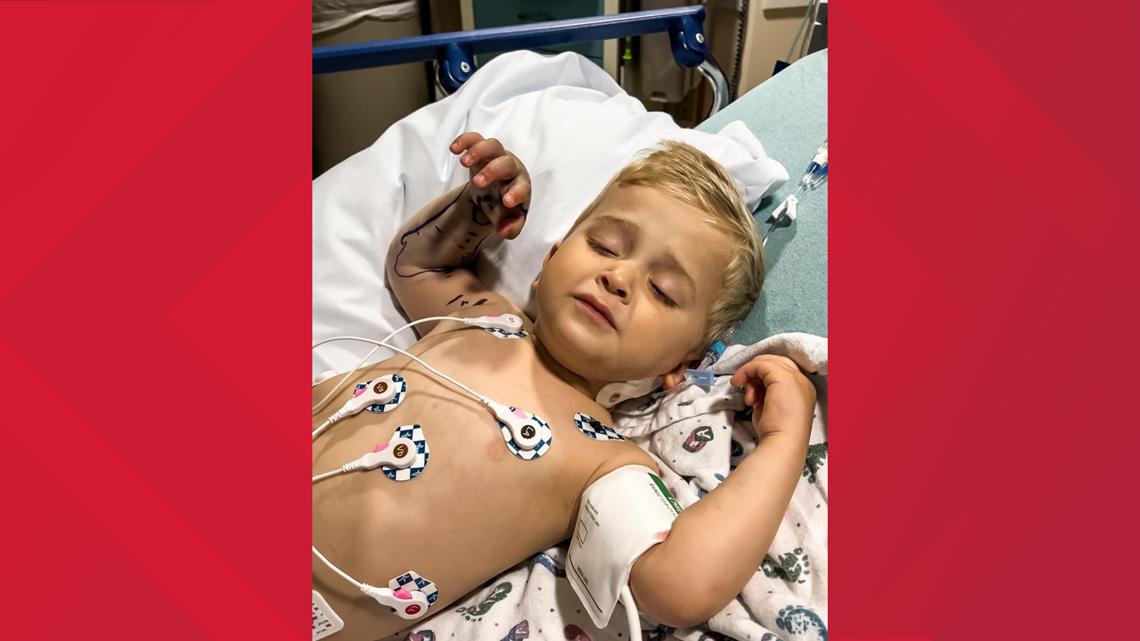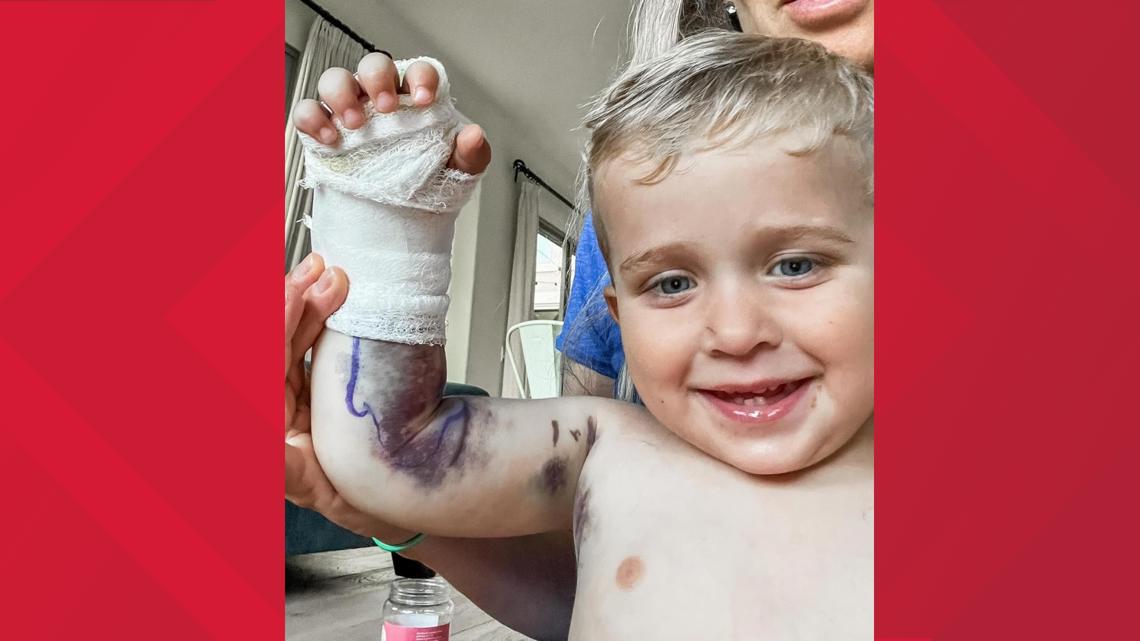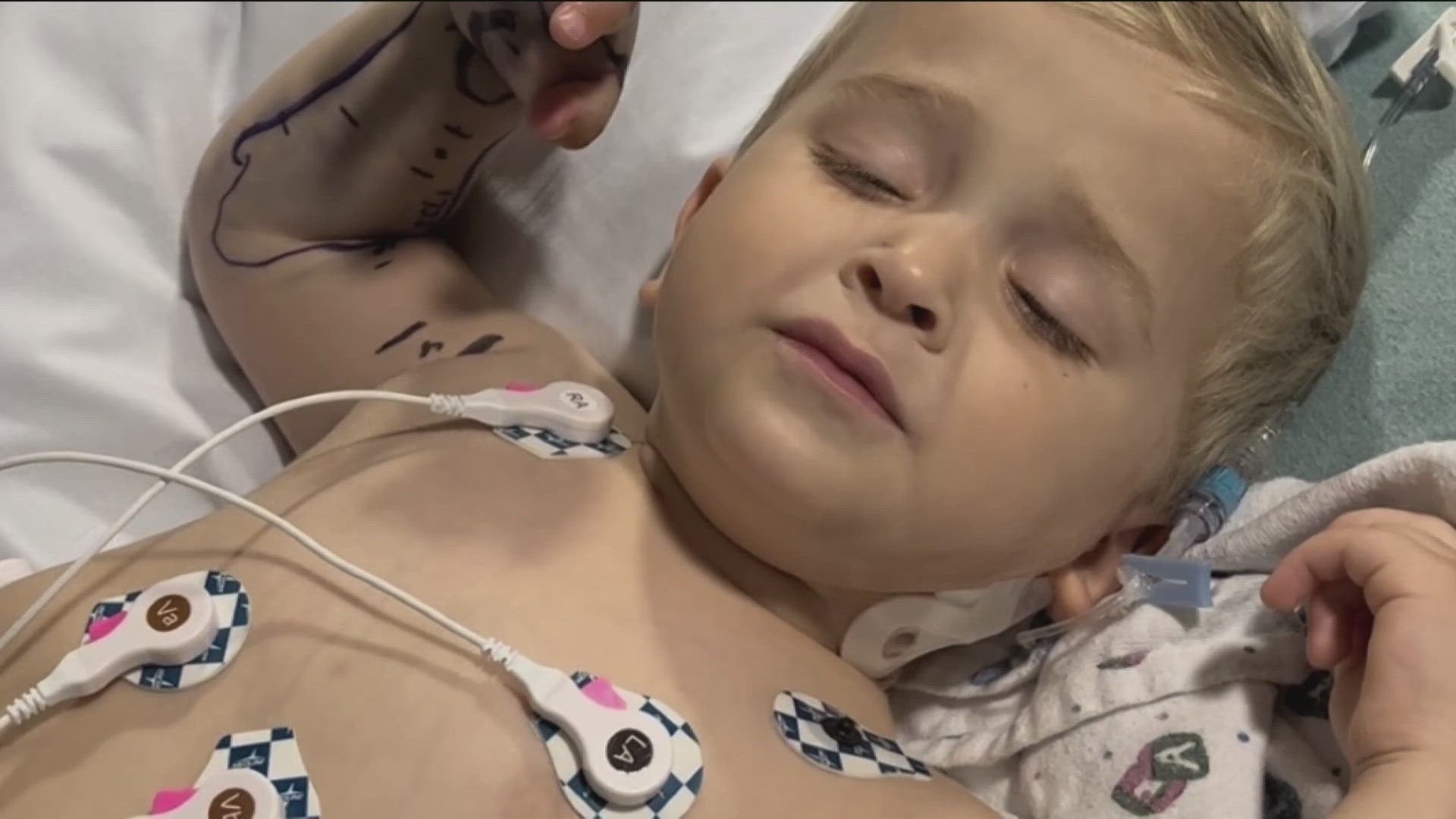SAN DIEGO — A Del Sur family is traumatized after their two-year-old son nearly died from a rattlesnake bite in early May.
The family did everything right and reacted fast.
But they said because you can't simply go to your nearest urgent care and get anti-venom, anyone with children could be in a life-or-death situation because of a poisonous snake bite.
Weeks after the bite, two-year-old Briggs depends on his left hand for a snack or to play with his toys. Unable to fully use his right hand after a dangerously poisonous Southern Pacific Rattlesnake bit him between his thumb and forefinger.
Briggs' family was outside in the backyard when it happened. His mother Lindsay Pfeffer says Briggs came to her showing her his thumb.
“I looked and all I saw was a drop of blood on his finger, like the smallest little drop you could not see any bite," Lindsay said.
She wasn’t sure what happened and thought it was a bee sting until his older brother saw what was hiding behind the fire pit.
“He was like- 'snake!' And I looked over and saw a rattlesnake," Lindsay said.
A 911 dispatcher told them to wait at home for an ambulance since urgent care does not carry anti-venom. So, the family waited at home for an ambulance to arrive.
Once an ambulance arrived, the family needed to go to the emergency room at Palomar Medical Center in Escondido, 25 minutes away since the nearest emergency room didn't have anti-venom.


The poison was quickly moving through Briggs' 25-pound body.
“He was laying down on the sidewalk out front. Just flat and sweating and he wasn't moving,” Lindsay said.
First responders tracked and marked the poison moving up his arm, turning it black. By the time they arrived at Palomar’s emergency room, they couldn’t start an IV.
The snake poison was constricting his veins. Lindsay thought she would lose her little boy who had just turned two.
“I thought he was going to die. We all thought he was going to die. Even the doctor thought he was going to die. When they started to put the pads on to shock him and I saw his blood pressure going down and they took the labs and I knew it wasn't good and his whole arm was black- I don't want his last memory to be of me screaming," Lindsay said.
As a last resort, the Palomar ER team drilled into his leg using a rarely used procedure called intraosseous vascular access to start an IV.
They inserted a needle into Briggs' leg and then used a handheld drill to push the needle into his bone. That’s how they were able to finally get him the anti-venom. Then, they had to send him to Rady Children’s Hospital, now nearly an hour away.


Briggs stayed in the ICU at Rady for several days. Doctors were still unsure he would make it.
“They said platelets of 13 you don't live. Nobody understands how he's alive. This is underheard of why he actually made it," she said.
It took 30 vials of anti-venom to bring Briggs back. For blood to flow back into his arm and fingers.
“Because he's 2 he's more likely to die but because he’s 2 he's more likely to heal. But you have to survive to get there," she said.
CBS 8 reached out to Sharp, Scripps, and UC San Diego Health Systems.
The healthcare providers said, if bitten by a rattlesnake, call 911 first. Urgent Cares do not have anti-venom. They can stabilize someone and arrange transport to an emergency room.
But remember, time is of the essence. And it’s that lack of access to urgent cares, that worries Briggs' mother, Lindsay, even today. “Get kids stable and then take them to Rady. I could have gotten him stable at Sharp in 5 minutes and then gone down to Rady, but there's not that option,” she says.
What hospitals recommend
Sharp Rees-Stealy
- While SRS Urgent Care (UC) facilities do not carry anti-venom, in most cases, the protocol for treating a snake bite in the UC would involve stabilizing the patient and administering basic first aid while arranging for transportation to a hospital equipped to handle snake bites.
- If a child comes in with a snake bite, depending on the severity of the bite and the type of snake, treatment might commence at the Urgent Care facility while arrangements are made to transfer the child to a pediatric facility like Rady Children’s Hospital for specialized care if needed. Patients who present with a rattlesnake bite will always be transferred to the ED.
Sharp Hospitals
(Sharp Chula Vista Medical Center, Sharp Grossmont Hospital, Sharp Memorial Hospital)
The emergency departments at Sharp Chula Vista Medical Center, Sharp Grossmont Hospital and Sharp Memorial Hospital all carry antivenom. For patients who present with a snake bite, the response would include administering the antivenom and appropriate treatment for allergic reactions, wound care and continuous monitoring.
Pediatric snake bite patients will be treated immediately pending their presentation and situation, but if it requires admission, the patients would be transferred to Rady’s Children’s Hospital.
Scripps
Click here for what Scripps recommends you should do in case of a snake bite.
UC San Diego Health says these hospital ERs have anti-venom:
- East Campus Medical Center
- Jacobs Medical Center
- Hillcrest Medical Center
WATCH RELATED: Rattlesnake sightings are on the rise. Here's what to do if you spot one

